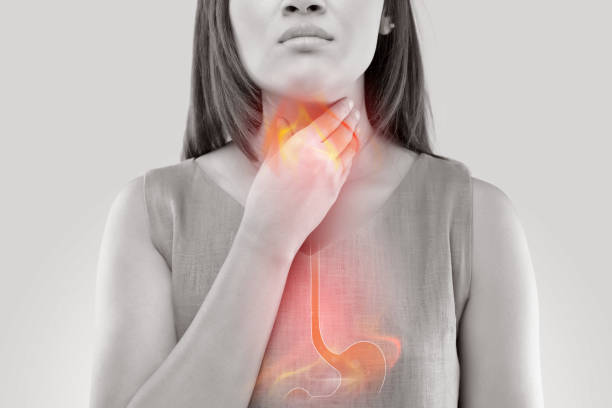Gastroesophageal Reflux Disease occurs when the lower esophageal sphincter (LES), a muscular valve at the lower end of the esophagus, relaxes inappropriately or weakens. This allows stomach acid and occasionally bile to flow back (reflux) into the esophagus, irritating its lining. Over time, this repetitive exposure to stomach acid can lead to inflammation (esophagitis), erosions, ulcers, and potentially more serious complications like Barrett’s esophagus or esophageal cancer.
The symptoms of GERD can vary widely but often include heartburn, regurgitation of sour or bitter-tasting acid into the throat or mouth, difficulty swallowing, and chest pain. These symptoms can significantly impact daily life, affecting sleep, eating habits, and overall well-being.
Managing GERD typically involves lifestyle modifications, such as dietary changes, weight management, and elevating the head of the bed, along with medications to reduce stomach acid production or strengthen the LES. In severe cases, surgical interventions like fundoplication may be considered to tighten the LES and prevent reflux.
Understanding the complexities of GERD, including its risk factors and potential complications, is essential for individuals and healthcare providers alike to effectively treat and manage this chronic condition.
Table of Contents
Types of Gastroesophageal Reflux Disease

In the context of Gastroesophageal Reflux Disease (GERD), there aren’t distinct “types” in the same way as other medical conditions. However, GERD can manifest with varying severity and presentations, which may be classified based on the frequency and intensity of symptoms, as well as associated complications. Here are some common categorizations:
- Non-Erosive Reflux Disease (NERD):
- This refers to GERD without visible signs of esophageal injury or inflammation on endoscopy. Despite the absence of erosions or ulcers, individuals with NERD experience typical symptoms such as heartburn and regurgitation.
- Erosive Esophagitis:
- Erosive esophagitis is characterized by visible damage to the lining of the esophagus, typically seen during endoscopy. The severity can range from mild inflammation to severe ulceration.
- Barrett’s Esophagus:
- In some cases, chronic exposure to stomach acid due to GERD can lead to changes in the cells lining the lower esophagus. This condition, known as Barrett’s esophagus, is considered a precancerous condition because it increases the risk of developing esophageal adenocarcinoma.
- Refractory GERD:
- Refractory GERD refers to cases where symptoms persist despite adherence to treatment and lifestyle modifications. This may require more intensive management strategies, including higher doses of medications or consideration of surgical options.
- Extraesophageal Manifestations:
- GERD can also present with symptoms outside the esophagus, such as chronic cough, hoarseness, asthma exacerbations, and dental erosions. These are collectively known as extraesophageal manifestations or atypical GERD symptoms.
While these classifications help describe the varying presentations and complications of GERD, treatment approaches are often tailored to individual symptoms and severity. Effective management typically involves a combination of lifestyle modifications, medications, and sometimes surgical intervention to alleviate symptoms and prevent long-term complications.
Symptoms of Gastroesophageal Reflux Disease

Symptoms of Gastroesophageal Reflux Disease (GERD) can vary in severity and presentation but typically include:
- Heartburn: A burning sensation in the chest, often after eating, which may worsen when lying down or bending over.
- Regurgitation: Sour or bitter-tasting acid backing up into the throat or mouth, especially after meals or when lying down.
- Dysphagia: Difficulty swallowing, often feeling like food is stuck in the throat or chest.
- Chronic Cough: A persistent cough, especially at night or after eating, due to irritation of the throat caused by acid reflux.
- Hoarseness or Sore Throat: Irritation of the vocal cords or throat, leading to hoarseness or a persistent sore throat.
- Chest Pain: Sometimes mistaken for heart-related pain (angina), chest discomfort can occur due to acid reflux irritating the esophagus.
- Bloating or Belching: Excessive gas production or belching, often associated with discomfort in the upper abdomen.
- Laryngitis: Inflammation of the voice box (larynx), leading to voice changes or loss of voice.
- Dental Erosion: Acid reflux can erode tooth enamel, leading to tooth sensitivity or decay.
- Respiratory Issues: Wheezing, asthma exacerbations, or recurrent pneumonia due to inhalation of acid into the lungs (aspiration).
These symptoms can vary in frequency and severity among individuals. Some may experience occasional mild symptoms, while others may have persistent and severe manifestations that significantly impact daily life and overall well-being. It’s important to seek medical evaluation if experiencing frequent or severe GERD symptoms to prevent complications and receive appropriate treatment.
Causes of Gastroesophageal Reflux Disease

Gastroesophageal Reflux Disease (GERD) is primarily caused by dysfunction of the lower esophageal sphincter (LES) and other contributing factors that increase the likelihood of stomach acid refluxing into the esophagus. Here are the main causes and contributing factors:
- Lower Esophageal Sphincter (LES) Dysfunction:
- The LES is a circular muscle at the junction of the esophagus and stomach that acts as a valve to prevent stomach contents, including acid, from refluxing into the esophagus. In GERD, the LES may relax abnormally or weaken, allowing acid to escape upward.
- Hiatal Hernia:
- A hiatal hernia occurs when part of the stomach protrudes through the diaphragm into the chest cavity, which can weaken the LES and contribute to reflux.
- Dietary Factors:
- Certain foods and beverages can trigger or worsen GERD symptoms, including spicy or fatty foods, citrus fruits, tomatoes, chocolate, caffeine, alcohol, and carbonated beverages.
- Obesity:
- Excess body weight, particularly around the abdomen, increases pressure on the stomach and can push stomach contents up into the esophagus.
- Pregnancy:
- Hormonal changes and the growing uterus during pregnancy can increase intra-abdominal pressure, leading to reflux.
- Smoking:
- Smoking weakens the LES and increases stomach acid production, making reflux more likely.
- Certain Medications:
- Some medications can relax the LES or irritate the esophagus, contributing to GERD symptoms. These include NSAIDs (like aspirin or ibuprofen), certain muscle relaxants, and calcium channel blockers used for high blood pressure.
- Delayed Gastric Emptying (Gastroparesis):
- Conditions that delay stomach emptying, such as diabetes or nerve damage, can increase the likelihood of reflux.
- Connective Tissue Disorders:
- Rarely, connective tissue disorders such as scleroderma can affect the esophageal muscles and impair LES function, leading to GERD.
- Heavy Meals or Eating Patterns:
- Eating large meals, lying down immediately after eating, or eating late at night can increase the risk of reflux by putting pressure on the LES and allowing stomach contents to reflux into the esophagus.
Understanding these causes and risk factors can help individuals manage GERD symptoms more effectively through lifestyle modifications, medication management, and, in some cases, surgical interventions. It’s essential to work closely with healthcare providers to identify and address the underlying causes contributing to GERD and develop a personalized treatment plan.
Risk Factors
Several factors can increase the risk of developing Gastroesophageal Reflux Disease (GERD). These risk factors can either contribute to the weakening of the lower esophageal sphincter (LES) or increase the likelihood of stomach acid refluxing into the esophagus. Here are some common risk factors associated with GERD:
- Obesity: Excess body weight, especially around the abdomen, increases pressure on the stomach and LES, promoting reflux.
- Hiatal Hernia: This condition, where part of the stomach protrudes through the diaphragm into the chest cavity, can weaken the LES and contribute to GERD.
- Smoking: Smoking weakens the LES and increases stomach acid production, making reflux more likely.
- Dietary Factors: Certain foods and beverages, such as spicy or fatty foods, citrus fruits, tomatoes, chocolate, caffeine, alcohol, and carbonated beverages, can trigger or worsen GERD symptoms.
- Pregnancy: Hormonal changes and the growing uterus can increase intra-abdominal pressure, leading to reflux during pregnancy.
- Delayed Gastric Emptying (Gastroparesis): Conditions that delay stomach emptying, such as diabetes or nerve damage, can increase the risk of reflux.
- Certain Medications: Some medications can relax the LES or irritate the esophagus, contributing to GERD symptoms. These include NSAIDs (like aspirin or ibuprofen), certain muscle relaxants, and calcium channel blockers used for high blood pressure.
- Connective Tissue Disorders: Rarely, connective tissue disorders such as scleroderma can affect the esophageal muscles and impair LES function, leading to GERD.
- Eating Habits: Eating large meals, lying down immediately after eating, or eating late at night can increase the risk of reflux by putting pressure on the LES and allowing stomach contents to reflux into the esophagus.
- Age: GERD becomes more common with age, possibly due to weakening of the LES and other age-related changes in the digestive system.
- Stress: While stress itself may not directly cause GERD, it can exacerbate symptoms in individuals who already have the condition.
Understanding these risk factors can help individuals and healthcare providers identify those at higher risk for GERD and implement preventive measures or early treatment strategies. Lifestyle modifications, dietary changes, weight management, and smoking cessation are crucial in reducing the risk and severity of GERD symptoms.
Diagnosis

Diagnosing Gastroesophageal Reflux Disease (GERD) typically involves a combination of clinical evaluation, symptom assessment, and sometimes diagnostic tests to confirm the presence and severity of reflux and related complications. Here are the main approaches used in diagnosing GERD:
- Medical History and Symptom Evaluation:
- Your healthcare provider will begin by discussing your symptoms, their frequency, severity, and any factors that worsen or alleviate them. Typical symptoms include heartburn, regurgitation, chest pain, difficulty swallowing, and others associated with reflux.
- Physical Examination:
- A physical examination may be conducted to assess for signs such as chest discomfort, throat irritation, or signs of complications like weight loss.
- Trial of Empirical Therapy:
- In cases where symptoms strongly suggest GERD but no complications are evident, healthcare providers may initiate a trial of acid-suppressive therapy (such as proton pump inhibitors or PPIs) to see if symptoms improve. This can help confirm GERD as the cause of symptoms.
- Endoscopy:
- An upper endoscopy (esophagogastroduodenoscopy or EGD) may be recommended to visually examine the esophagus and stomach lining. This procedure can detect inflammation (esophagitis), erosions, ulcers, strictures, Barrett’s esophagus, and other structural abnormalities caused by GERD. Biopsies can also be taken during endoscopy to rule out other conditions or confirm the presence of Barrett’s esophagus.
- Esophageal pH Monitoring:
- pH monitoring measures the amount of acid refluxing into the esophagus over a 24-hour period. This test is particularly useful in cases where symptoms persist despite treatment or when the diagnosis of GERD is uncertain.
- Esophageal Manometry:
- This test measures the pressure and coordination of muscle contractions in the esophagus. It helps assess the function of the LES and esophageal motility, which can be useful in diagnosing conditions like hiatal hernia or esophageal dysmotility that contribute to GERD.
- Barium Swallow or Upper GI Series:
- These imaging tests involve swallowing a barium solution that coats the lining of the esophagus, stomach, and upper intestine. X-rays are then taken to visualize the anatomy and detect abnormalities such as hiatal hernia or strictures.
The choice of diagnostic tests depends on the severity of symptoms, response to initial treatment, presence of complications, and individual patient factors. A comprehensive evaluation helps healthcare providers confirm the diagnosis of GERD, assess its severity, and tailor treatment to manage symptoms effectively and prevent complications.
Treatments

The treatment of Gastroesophageal Reflux Disease (GERD) aims to alleviate symptoms, heal esophageal damage, and prevent complications. Treatment strategies often involve a combination of lifestyle modifications, medications, and occasionally surgical interventions. Here are the main approaches to managing GERD:
- Lifestyle Modifications:
- Dietary Changes: Avoiding trigger foods such as spicy, fatty, or acidic foods, chocolate, caffeine, and alcohol. Eating smaller, more frequent meals and avoiding large meals before bedtime can also help.
- Weight Management: Losing excess weight, if overweight or obese, can reduce pressure on the stomach and LES, decreasing the likelihood of reflux.
- Elevating the Head of the Bed: Raising the head of the bed by 6 to 8 inches or using a wedge pillow can prevent acid reflux during sleep.
- Avoiding Tight Clothing: Tight belts or waistbands can increase pressure on the abdomen, worsening reflux symptoms.
- Smoking Cessation: Quitting smoking can improve LES function and reduce acid production.
- Medications:
- Proton Pump Inhibitors (PPIs): These medications block acid production in the stomach, allowing the esophagus to heal and reducing symptoms. Examples include omeprazole (Prilosec), esomeprazole (Nexium), and lansoprazole (Prevacid).
- H2 Blockers: These medications reduce the production of stomach acid and include ranitidine (Zantac) and famotidine (Pepcid).
- Antacids: Over-the-counter antacids, such as Tums or Maalox, can provide quick relief by neutralizing stomach acid.
- Surgical Interventions:
- Fundoplication: In cases where medications and lifestyle changes do not adequately control GERD, surgical procedures like fundoplication may be considered. This involves wrapping the upper part of the stomach around the LES to strengthen it and prevent reflux.
- LINX Device: This is a small, flexible ring of magnetic beads that is surgically placed around the LES to strengthen it and prevent reflux while allowing food to pass through.
- Endoscopic Treatments:
- Endoscopic Radiofrequency Ablation (Stretta Procedure): This minimally invasive procedure uses radiofrequency energy to strengthen the LES and reduce reflux symptoms.
- Management of Complications:
- Treatment may also include managing complications such as esophagitis, strictures (narrowing of the esophagus), Barrett’s esophagus, or respiratory complications caused by GERD.
- Regular Monitoring and Follow-up:
- It’s essential for individuals with GERD to have regular check-ups with their healthcare providers to monitor symptoms, assess treatment effectiveness, and detect any complications early.
The choice of treatment depends on the severity of symptoms, presence of complications, individual patient factors, and response to initial therapies. A personalized treatment plan, often involving a combination of approaches, can effectively manage GERD and improve quality of life for individuals affected by this chronic condition.
Prevention

Preventing Gastroesophageal Reflux Disease (GERD) involves adopting lifestyle modifications and strategies that reduce the likelihood of acid reflux and its associated symptoms. While not all cases of GERD can be prevented, these preventive measures can help minimize the risk and severity of reflux:
- Maintain a Healthy Weight:
- Excess weight, especially around the abdomen, increases pressure on the stomach and LES, promoting reflux. Maintaining a healthy weight through diet and regular exercise can reduce this risk.
- Modify Eating Habits:
- Avoid Trigger Foods: Identify and avoid foods that trigger reflux symptoms, such as spicy, fatty, or acidic foods, chocolate, caffeine, and alcohol.
- Eat Smaller, More Frequent Meals: Consuming smaller meals more frequently throughout the day can reduce pressure on the LES and decrease the likelihood of reflux.
- Avoid Eating Late at Night: Eating close to bedtime increases the risk of reflux. Finish meals at least 2-3 hours before lying down or going to bed.
- Adjust Sleeping Position:
- Elevate the Head of the Bed: Raising the head of the bed by 6 to 8 inches using bed risers or a wedge pillow can help prevent stomach acid from refluxing into the esophagus during sleep.
- Quit Smoking:
- Smoking weakens the LES and increases stomach acid production, making reflux more likely. Quitting smoking can improve LES function and reduce reflux symptoms.
- Limit Alcohol Intake:
- Alcohol can relax the LES and increase stomach acid production, contributing to reflux. Limiting alcohol consumption or avoiding it altogether can help prevent GERD symptoms.
- Manage Stress:
- Stress doesn’t directly cause GERD, but it can exacerbate symptoms in individuals who already have the condition. Practice stress-reducing techniques such as deep breathing, meditation, or yoga to help manage stress levels.
- Medication Awareness:
- Be mindful of medications that can aggravate GERD symptoms, such as NSAIDs (like aspirin or ibuprofen), certain muscle relaxants, and calcium channel blockers used for high blood pressure. If possible, discuss alternative medications with your healthcare provider.
- Avoid Tight Clothing:
- Wearing tight belts, waistbands, or other clothing that puts pressure on the abdomen can worsen reflux symptoms. Opt for loose-fitting clothing to reduce abdominal pressure.
- Regular Exercise:
- Engaging in regular physical activity not only helps maintain a healthy weight but can also improve digestive health and reduce the risk of reflux.
- Stay Informed and Seek Medical Advice:
- If you experience persistent or severe symptoms of GERD despite lifestyle modifications, seek medical advice promptly. Early diagnosis and intervention can help prevent complications and improve treatment outcomes.
By incorporating these preventive measures into your daily routine, you can help reduce the frequency and severity of GERD symptoms, improve overall digestive health, and enhance your quality of life.
Related Conditions
Gastroesophageal Reflux Disease (GERD) can be associated with several related conditions and complications, often due to the chronic exposure of the esophagus to stomach acid. These related conditions may include:
- Esophagitis: Inflammation of the esophagus due to acid reflux, which can lead to symptoms such as pain, difficulty swallowing, and in severe cases, ulcers or bleeding.
- Barrett’s Esophagus: A condition where the lining of the esophagus changes to resemble the lining of the intestine. Barrett’s esophagus is considered a precancerous condition because it increases the risk of developing esophageal adenocarcinoma, a type of cancer.
- Esophageal Strictures: Narrowing of the esophagus due to chronic inflammation and scarring caused by refluxed stomach acid. This can lead to difficulty swallowing and may require treatment to widen the esophagus (dilation).
- Respiratory Complications: Chronic aspiration of stomach acid into the lungs can lead to respiratory symptoms such as cough, asthma exacerbations, recurrent pneumonia, or bronchitis.
- Dental Erosion: Acid reflux can erode tooth enamel over time, leading to tooth sensitivity, cavities, or tooth decay.
- Laryngopharyngeal Reflux (LPR): Also known as silent reflux, LPR occurs when stomach acid reaches the throat and voice box (larynx), causing symptoms such as hoarseness, chronic cough, or throat clearing.
- Asthma: Some studies suggest a possible link between GERD and asthma, where acid reflux may exacerbate asthma symptoms or make asthma more difficult to control.
- Hiatal Hernia: A condition where part of the stomach protrudes through the diaphragm into the chest cavity, which can weaken the lower esophageal sphincter (LES) and contribute to GERD symptoms.
- Peptic Ulcers: While typically associated with Helicobacter pylori infection or NSAID use, peptic ulcers can also be worsened by GERD due to increased stomach acid secretion and impaired healing of the ulcerated tissue.
- Erosive Gastritis: Inflammation and erosion of the stomach lining caused by stomach acid, which can occur alongside GERD and exacerbate symptoms.
Managing GERD effectively through lifestyle modifications, medications, and, in some cases, surgical interventions can help reduce the risk of these related conditions and improve overall digestive health. Regular monitoring and follow-up with healthcare providers are important to detect and manage any complications early.
Living With Gastroesophageal Reflux Disease
Living with Gastroesophageal Reflux Disease (GERD) can be challenging, but with proper management and lifestyle adjustments, individuals can often minimize symptoms and improve their quality of life. Here are some strategies and tips for living well with GERD:
- Dietary Modifications:
- Identify and avoid trigger foods that worsen your symptoms, such as spicy, fatty, acidic foods, caffeine, chocolate, and alcohol.
- Eat smaller, more frequent meals throughout the day to reduce pressure on the LES and prevent stomach distension.
- Keep a food diary to track which foods or beverages exacerbate your symptoms and adjust your diet accordingly.
- Lifestyle Adjustments:
- Maintain a healthy weight through regular exercise and a balanced diet. Excess weight can increase intra-abdominal pressure and worsen reflux.
- Avoid lying down immediately after meals. Try to wait at least 2-3 hours before lying down or going to bed.
- Elevate the head of your bed by 6 to 8 inches using bed risers or a wedge pillow to prevent acid reflux during sleep.
- Wear loose-fitting clothing to avoid putting pressure on your abdomen, which can exacerbate reflux symptoms.
- Smoking Cessation:
- If you smoke, quitting can significantly improve LES function and reduce stomach acid production, thereby alleviating GERD symptoms.
- Medication Management:
- Take prescribed medications as directed by your healthcare provider, such as proton pump inhibitors (PPIs) or H2 blockers, to reduce stomach acid production and heal esophageal damage.
- Be aware of any potential side effects of medications and discuss any concerns with your healthcare provider.
- Stress Management:
- Practice stress-reducing techniques such as deep breathing, meditation, or yoga, as stress can exacerbate GERD symptoms.
- Regular Monitoring and Check-ups:
- Attend regular follow-up appointments with your healthcare provider to monitor your condition, assess treatment effectiveness, and detect any complications early.
- Discuss any new or persistent symptoms with your healthcare provider promptly to adjust your treatment plan as needed.
- Educate Yourself:
- Learn about GERD, its causes, symptoms, and treatment options to empower yourself in managing the condition effectively.
- Stay informed about lifestyle changes and advancements in treatment options for GERD through reliable sources and discussions with your healthcare provider.
- Support System:
- Seek support from family, friends, or support groups to cope with the challenges of living with a chronic condition like GERD.
- Share your experiences and learn from others who may have similar experiences managing GERD.
By implementing these strategies and working closely with your healthcare team, you can reduce the frequency and severity of GERD symptoms, improve your overall well-being, and maintain a fulfilling lifestyle.
Conclusion
In conclusion, Gastroesophageal Reflux Disease (GERD) is a chronic condition characterized by the reflux of stomach acid into the esophagus, leading to symptoms such as heartburn, regurgitation, and chest discomfort. Managing GERD effectively involves a multifaceted approach that includes lifestyle modifications, medication management, and in some cases, surgical interventions. By implementing dietary changes, maintaining a healthy weight, avoiding triggers, and adhering to prescribed treatments, individuals can often alleviate symptoms and improve their quality of life.
Regular monitoring and follow-up with healthcare providers are crucial to assess treatment effectiveness, monitor for complications like esophagitis or Barrett’s esophagus, and adjust the treatment plan as needed. Education about GERD, its causes, and management strategies empowers individuals to make informed decisions and take proactive steps in managing their condition.
While living with GERD may require ongoing attention and adjustments, many people find relief and maintain a good quality of life by incorporating these strategies into their daily routines. Seeking support from healthcare professionals, family, and friends can also provide valuable encouragement and assistance in coping with the challenges of living with GERD.
